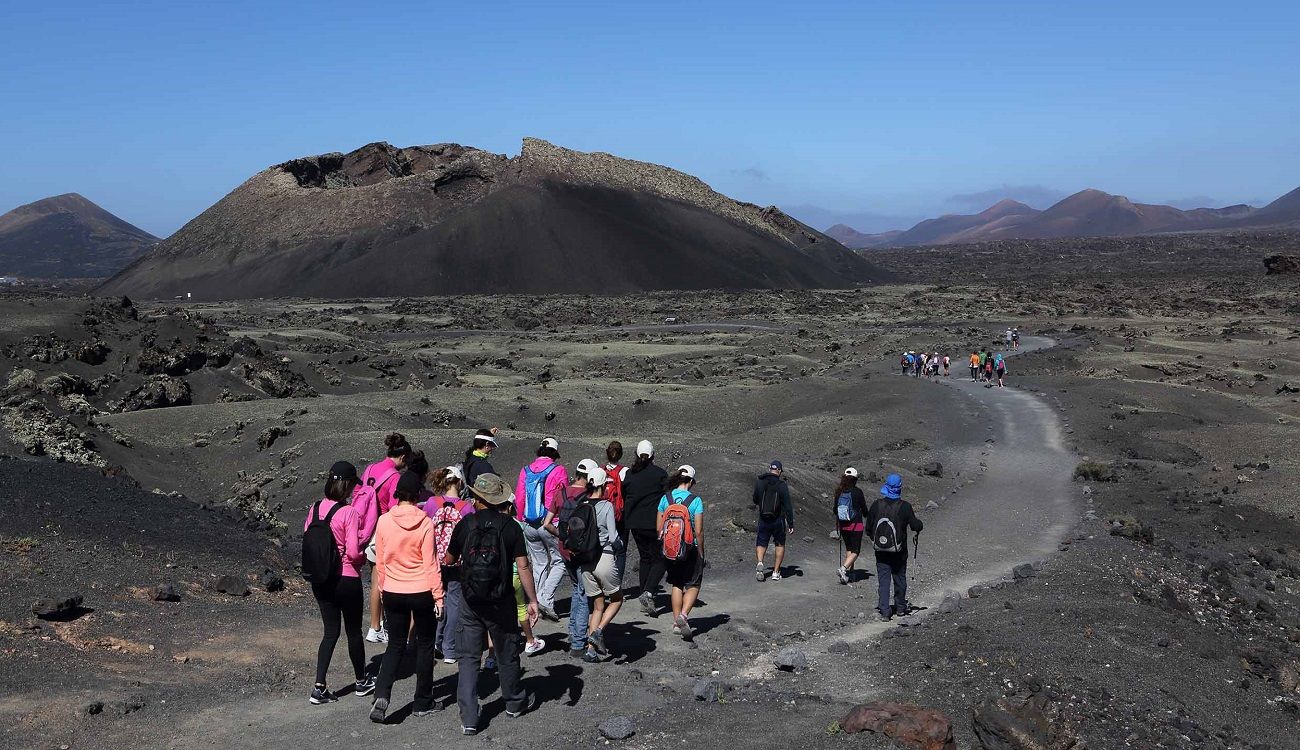Lanzarote is a perfect island to get to know through its routes and trails, that cross volcanic landscapes, beaches and charming towns, scattered throughout the island's geography.
Besides, it is not necessary to be an expert hiker or to be in a particularly good physical condition to do several of them, since there are very easy routes that you can do as a family, even with the little ones.
1. Volcán del Cuervo
If you are looking for a relaxed route, that you can do as a family or with older people, volcano El Cuervo, located in the municipality of Tinajo, is the best option. It is a circular hiking route, without elevation of the terrain, that surrounds this peculiar dark-colored volcano that is more than 380 meters high.
Along the way you can enjoy the landscape, made up of an extensive mass of petrified lava and many other volcanoes such as Montaña Colorada. You will also have the opportunity to enter the crater and see the flora that has risen from the ashes, as well as the occasional Lanzarote lizard.
From the car park, it takes just 20 minutes to reach the base of the volcano and, once there, you will have two options. Either you go around it entirely, for that purpose you will have to walk to the left, or you go directly to the crater using the path to the right. In both cases, the round trip from the car park is approximately one hour.

2. Tremesana route in Yaiza
For the intrepid ones who wish to walk among volcanoes and closely observe landscapes taken from planet Mars, the ideal path is the Tremesana route, in the municipality of Yaiza.
It is a longer route, about two kilometers and three hours long, in the Timanfaya National Park, perfect to do with the family, even with the little ones.
The meeting point to start the route is at the Mancha Blanca Visitor Center and along the way you will not only visit places such as Encantada mountain, the Tremesana volcano and various jameos, but you will also learn about how the population of the area managed to adapt to difficult ground conditions. Up to twelve villages came to be buried under the ash and lava following the eruptions.
It is important to mention that it is a free guided route, although you need to book in advance to be able to do it, either online or at the Mancha Blanca Visitor Center. It is recommended to make a reservation in advance, since there are only eight daily places available in Spanish and eight in English.
Please remember that it is totally forbidden to take volcanic stones, since this is a protected area.

3. Montaña Colorada
The Montaña Colorada route can also be considered an educational trail very similar to the one of volcano El Cuervo. You will be able to enjoy its many shades of red along the path.
This three-kilometre circular way, which will also remind you of Mars, begins at the parking lot, just 500 meters from El Cuervo parking lot. The route will take you approximately one hour and it is not demanding at all as there are no changes in the elevation of the terrain.
During the tour, you will go around the crater of the mountain, which is obviously a volcano as well, and you will be able to enjoy the volcanic landscape and learn about it, thanks to its different information panels placed along the way.
In addition, be aware that one of the most popular photo opportunities is in front of "la Bomba", a large rock formation located in front of the volcano.

4 From Puerto Calero to Playa Quemada
If, on the other hand, you prefer to walk along the coast, enjoying sea views and end up taking a dip in a beach, a very simple route is the one that goes from Puerto Calero to Playa Quemada.
The trail begins on the Puerto Calero avenue and continues along the palm-lined avenue for about three kilometers until you reach the fishing village of Playa Quemada, which you will reach in just one hour. As it does not have any technical difficulty, it can be done with the little ones and the elderly.
And if this route has not been long enough for you, you can always continue the path a little further until you reach the hidden black sand beaches of Playa Quemada, such as La Arena or El Pozo, which are part of the Natural Monument of Los Ajaches.

